Hello, everyone! I hope you’re having a good August. This seems like as good a time as any to have another cookbook giveaway! One of the most tempting books to come across my desk in recent months has been Sarah Kieffer’s 100 Morning Treats, which is the latest installment in her ongoing series of books, and the followup to 100 Cookies.
If you don’t already know her work, Sarah is a terrific baker, and she has left no stone unturned in this book. Although they are titled “morning treats,” they are versatile enough to be served any time of day. Chapters are divided into Muffins, Scones, and Quick Breads; Coffee Cakes and Bundt Cakes; Sweet Yeasted and Fried Treats; Laminated Pastries; “The Weekend”; Base Doughs and Breads; and Extras. The selection is ridiculously complete.
I’ve only had a chance to try one recipe so far, and I chose the Banana Bread Scones, mainly because I had some very overripe bananas to use up when I was trying to move out of my house for three weeks. I chose to swap the scones’ Rum Glaze out for her Maple Icing, because two of my customers were 3 and 6 years old, and Sarah suggested this would be a good swap. It was!
I didn’t have enough time to mix the scones in the morning, when I wanted to serve them, so I veered slightly from the directions and froze them overnight (Sarah instructs us to freeze them for 30 minutes so they hold their shape). I let them warm up for about 15 minutes before popping them in the oven. They did slump a little, and took a few minutes longer to bake, but they were still delicious!
I asked Sarah if I could share the recipe with you here, and she kindly obliged, so keep reading for that. I also asked her a few questions, and decided to broach the subject that all of us professional recipe developers have to contend with, which is how to deal with all the food leftover from our experiments, and also how to maintain balance in our lives with so much temptation around. I appreciate how honest Sarah was in her answers. Although we love what we do, this job does have its challenges, and I hope this gives you some insight into that.
Keep reading for that Q&A with Sarah and the recipe. But first…
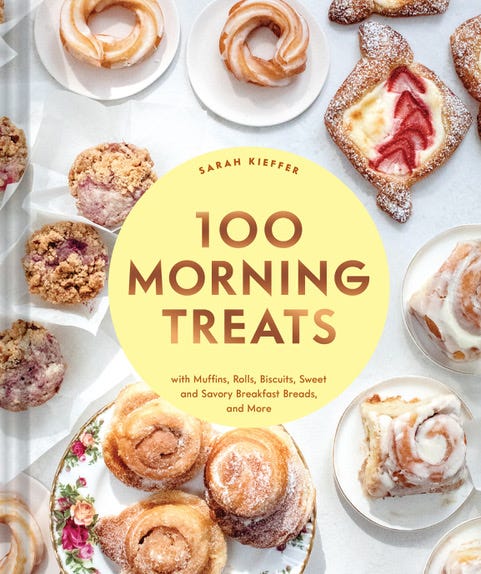
Enter to Win a Copy of 100 Morning Treats!
To enter1, tell me in the comments why you want — no, why you need this book — and I’ll pick a winner at random on Monday, August 21.
Q&A with Sarah Kieffer
SS: For those who may not know you — though you’d have to live under a rock not to — would you say it’s accurate to say that your pan-banging cookies are what put you on the map? Tell us the story.
SK: The pan-banging cookies definitely helped put my recipes on the map, ha. My first cookbook, The Vanilla Bean Baking Book, came out in 2016, and readers started making the pan-banging cookies (which had not been labeled that yet) and posting them on Instagram. Julia Moskin from The New York Times noticed the ripply cookies appearing all over her feed and reached out to feature them. The recipe appeared in the The Times in October 2017 and then went viral, which was wild.
SS: I’m curious to know the origin story of the pan-banging technique. What made you try it, not just at the end of the baking time (which bakers have done for years) but at intervals throughout the baking time? What were you trying to achieve?
SK: When I was writing the cookie chapter for my first book, I had already been using the tapping method (I worked at a bakery where I developed a chocolate chip cookie recipe that required two taps at the end of baking, to set the edges), and I was experimenting with a dough for thin and crispy cookies. While the cookies were baking, they kept spreading, and in frustration I kept banging the pan in the oven to try to set the edge to somehow stop it. I noticed ripply edges appearing on the cookies as I did so, and after they cooled and I tried them, I found the ridges created the crisp outer edge I had been searching for, but the center had remained soft. I loved it but thought the recipe was too high maintenance for a cookbook. I made them for Zoë François and she loved them and told me I had better put them in my cookbook — so I did, because I always listen to her.
SS: How did you know you had reached pan-banging perfection, and what is the science behind it?
SK: Bakers have been tapping their cookie pans for generations, of course, but the method I came up with is more methodical. The pan is tapped in the oven every few minutes towards the end of baking, and this creates the ripply edges. These cookies also have a higher granulated sugar-to-brown-sugar ratio, and the baked bottoms are very buttery. The white sugar helps with the spreading and keeps the edges crisp, and the extra butter in the dough also helps with the spreading.
SS: Moving on from cookies, your new book is called 100 Morning Treats, which is packed with delicious and creative takes on, well, morning treats. Basically anything that goes with a cup of coffee or tea. Personally I wouldn’t limit any of these to the morning hours, but I get it! What made you choose this particular subject this time around?
SK: Yes, of course, these treats can be consumed any time of day! But I wrote this book to celebrate the morning hours and the recipes of baked goods and pastries I developed while working in coffee shops and in my own home. I have a lot of nostalgia for ‘90s coffeehouse culture and spent a lot of time both as a patron of my neighborhood coffeehouse and working in many, as both a barista and a baker.
SS: This book has an adorable piece of yellow ric rac to use as a bookmark. Was this your idea or your designer’s? It’s such a small detail, but it makes me really happy when I use the book. It’s so cute!
SK: It was my designer's idea, Lizzie Vaughan, who has worked on all my books with Chronicle. I actually didn't know about it until I got my copy! But I fell in love with it instantly.
SS: Lastly, I have to ask you, if you don’t mind sharing: Do you have any strategies for dealing with the constant stream of warm pastries? Just so readers know, when an author embarks on a cookbook project, it’s about a year of non-stop recipe development. I struggle with this a lot myself, because I love to eat, and nothing compares to baked goods fresh from the oven. Do you have any rules for yourself?
SK: This is a hard question to answer — baking and eating sweets has always been a source of comfort for me, but has also also be tinged with shame. I have spent 10 years writing cookbooks basically non-stop, so there are always sweets in our house. My husband is a teacher, so during the school year he takes a lot of treats to school and leaves them in the teachers' lounge. My family lives nearby so they will come grab stuff, and our neighbors often get plates or pans left on their front doorstep. It is never wasted!
As for rules, I try to live by "all things in moderation," but food (and specifically sugar) is my vice of choice, and that has led to some unhealthy consequences, both physically and emotionally. This was true before I started writing books and sugar became my paycheck, so it's been a lot to untangle. I also have OCD and anxiety disorder, so when I am writing a book, recipe developing can become both an obsession and a compulsion, and it's all I can focus on (anxiety sets in when the book has been sent to press, and I can't sleep for weeks worrying about possible mistakes or it never being good enough). Throughout the last decade, things like exercise, or starting the day off with a healthy breakfast (and lunch) were often ignored, because I couldn't turn my mind off from the work I had to get done, and it seemed like too much time wasted to stop and eat, vs. snack on what I was making along the way. I didn't realize this was related to my OCD and not my work ethic. Therapy has been a necessity, and has helped me navigate healthy work boundaries for myself. Getting older and seeing consequences from not eating healthy consistently has also been a good push to make small changes.So, all that to say, I now try to start the day off with a cup of coffee and a few minutes off my phone, focusing on being silent and present. Then I take a brisk 20-minute walk and start my work day. As for food, I try my darndest to eat a really healthy breakfast and lunch, and keep my treat-eating to small bites if I am recipe testing. I also cut out alcohol if I am doing a lot of baking. Some days I am great at this, others I am not, ha. But I've found that deciding each morning that I am going to try to work in these parameters has overall led to positive life changes. I try very hard not to look at any food as bad, or myself as bad if I don't follow these guidelines I set for myself. There is a much bigger conversation about food and shame to be had (something I've struggled with my whole life), so words like "good" and "bad" are things I have in the past labeled myself as, and am trying to move away from, because they haven't helped with positive change in the long term.
I have found these particular things are helpful to me and my body, and my specific health issues and disorders. But, of course, it can look very different for each individual!
Sarah, thank you again for chatting with me, and for your candid reflections. You can find more of Sarah’s work here, or, of course, by picking up a copy of 100 Morning Treats or another one of her fabulous cookbooks.
Banana Bread Scones
From 100 Morning Sweets by Sarah Kieffer
Makes 8 scones
SCONES
1/2 cup [113 g] mashed bananas (about 1 ½ bananas)
1/3 cup [80 g] heavy cream, plus more for brushing
1 large egg
1 teaspoon pure vanilla extract
2 ¼ cups [320 g] all-purpose flour, plus more for dusting
1/3 cup [65 g] granulated sugar
1 tablespoon baking powder
1/2 teaspoon salt
12 tablespoons [1 ½ sticks or 170 g] cold unsalted butter, cut into 1/2-inch [12 mm] pieces
1/4 cup [30 g] pecans, toasted and chopped
RUM ICING
1 tablespoon unsalted butter, melted
1 to 2 tablespoons blackstrap rum or other dark rum
Pinch of salt 1 cup [120 g] confectioners’ sugar
FOR THE SCONES: Line a sheet pan with parchment paper. In a medium bowl or liquid measuring cup, whisk together the mashed bananas, heavy cream, egg, and vanilla. Refrigerate until ready to use.
In a large bowl, whisk together the flour, granulated sugar, baking powder, and salt.
Add the butter to the dry ingredients, and use a pastry cutter to cut in the butter until the flour-coated pieces are the size of peas. Add the chopped pecans and stir to combine. Add the refrigerated wet ingredients and fold with a spatula until just combined.
Transfer the dough to a generously floured surface and knead ten to twelve times, until it comes together, adding a little flour as necessary. Pat the dough into a square and roll it into a 12-inch [30.5 cm] square, dusting with flour as necessary. Fold the dough in thirds, like a business letter. Fold the dough in thirds again by folding in the short ends, making a square. Transfer it to the prepared sheet pan and put it in the freezer for 10 minutes.
Return the dough to the floured surface, shape it into a 12-inch [30.5 cm] square, and fold the dough in thirds again. Turn over the dough, so it’s seam-side down, and gently roll out the dough into a 12 by 4 in [30.5 by 10 cm] rectangle.
With a sharp knife, cut it crosswise into four equal rectangles, then cut each rectangle diagonally into two triangles. Transfer the triangles to the prepared sheet pan. Freeze the scones for 30 minutes.
Position an oven rack in the middle of the oven and preheat the oven to 375°F [190°C].
Brush the tops of the scones with a little heavy cream, making sure it doesn’t drip down the sides. Place another sheet pan under the scones, so the pans are double-stacked. Bake the scones, rotating the stacked pans halfway through, until the tops and bottoms are light golden brown, 18 to 25 minutes. Transfer the top sheet pan to a wire rack and let the scones cool slightly.
FOR THE ICING: While the scones are baking, in a small bowl, whisk together the melted butter, 1 tablespoon of the rum, and the salt. Add the confectioners’ sugar and mix together, then whisk until well combined and smooth. Add more rum (or water), 1 tablespoon at a time, if needed, to reach the desired consistency. Use the back of a spoon or an offset spatula to top each scone with the icing.
Scones are best eaten the same day they are made.
Maple Icing
1/4 cup [80 g] maple syrup
1 tablespoon unsalted butter, melted
1/2 teaspoon pure vanilla extract
Pinch of salt
1 cup [120 g] confectioners’ sugar
In a small bowl, whisk together the maple syrup, melted butter, vanilla, and salt. Add the confectioners’ sugar and mix together, then whisk until well combined and smooth.
Please review Veg Forward on Amazon!
I hope that those of you who ordered Veg Forward are enjoying it! As you may already know, leaving a review on Amazon (whether or not you purchased the book there) is really helpful to authors (like me) as it helps the book be more visible to more people. Thank you in advance!
Editor: Molly Ramsey
This giveaway is open to residents of the 50 United States and the District of Columbia, 18 years old or older. No purchase necessary. All federal, state, and local regulations apply. Limit one entry per person. Void where prohibited or restricted.

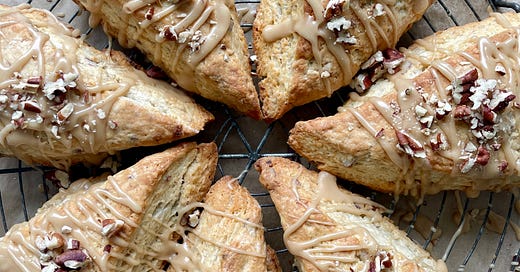



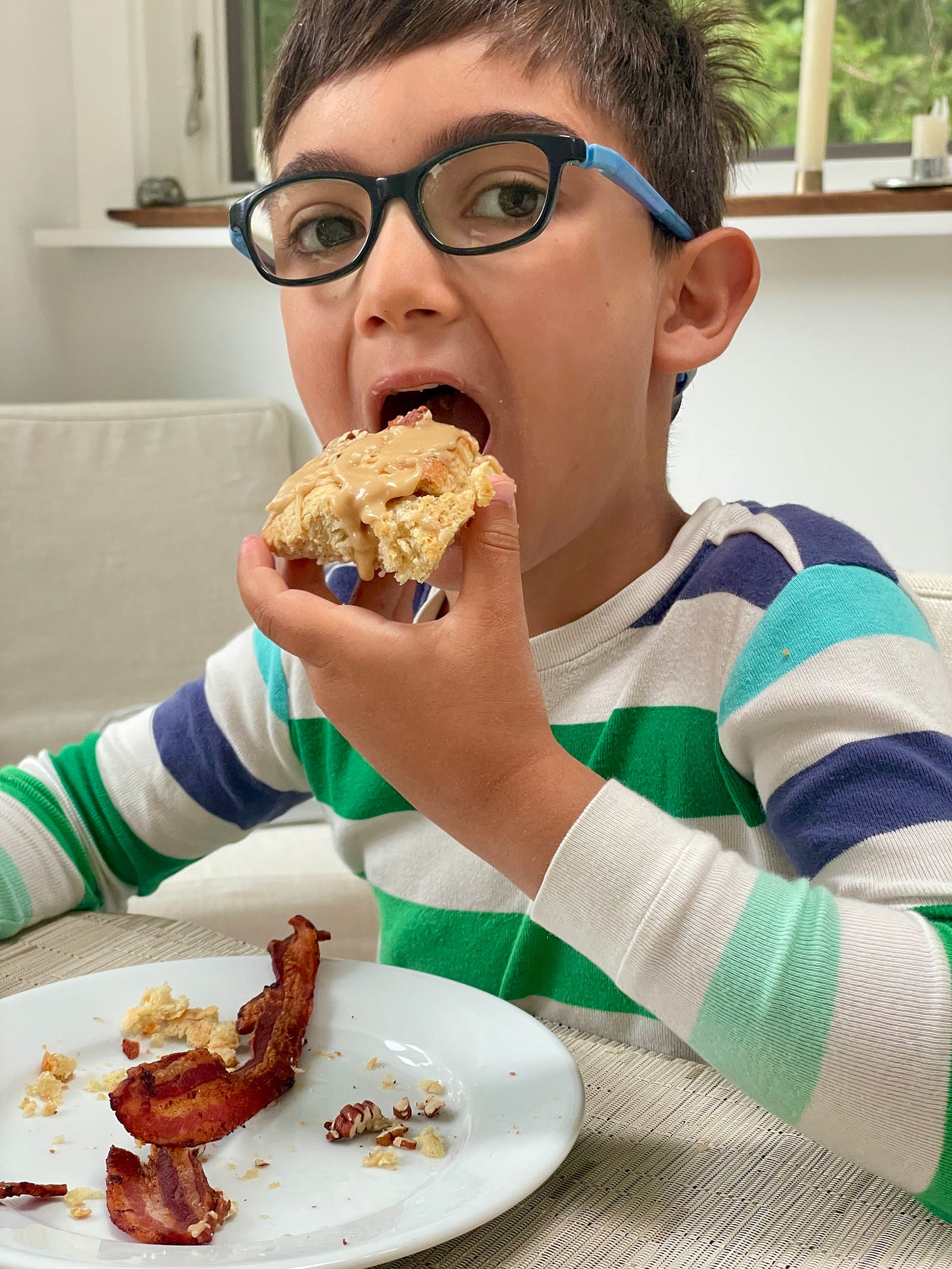
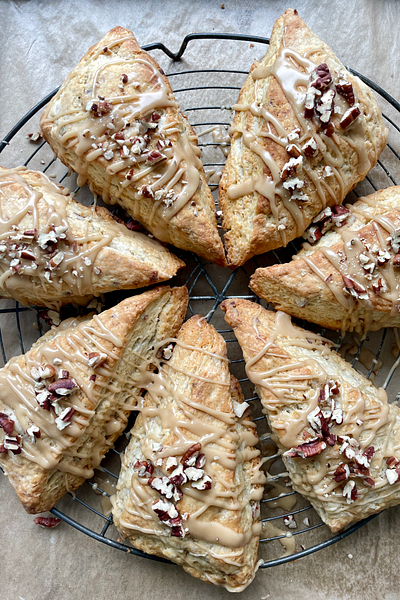
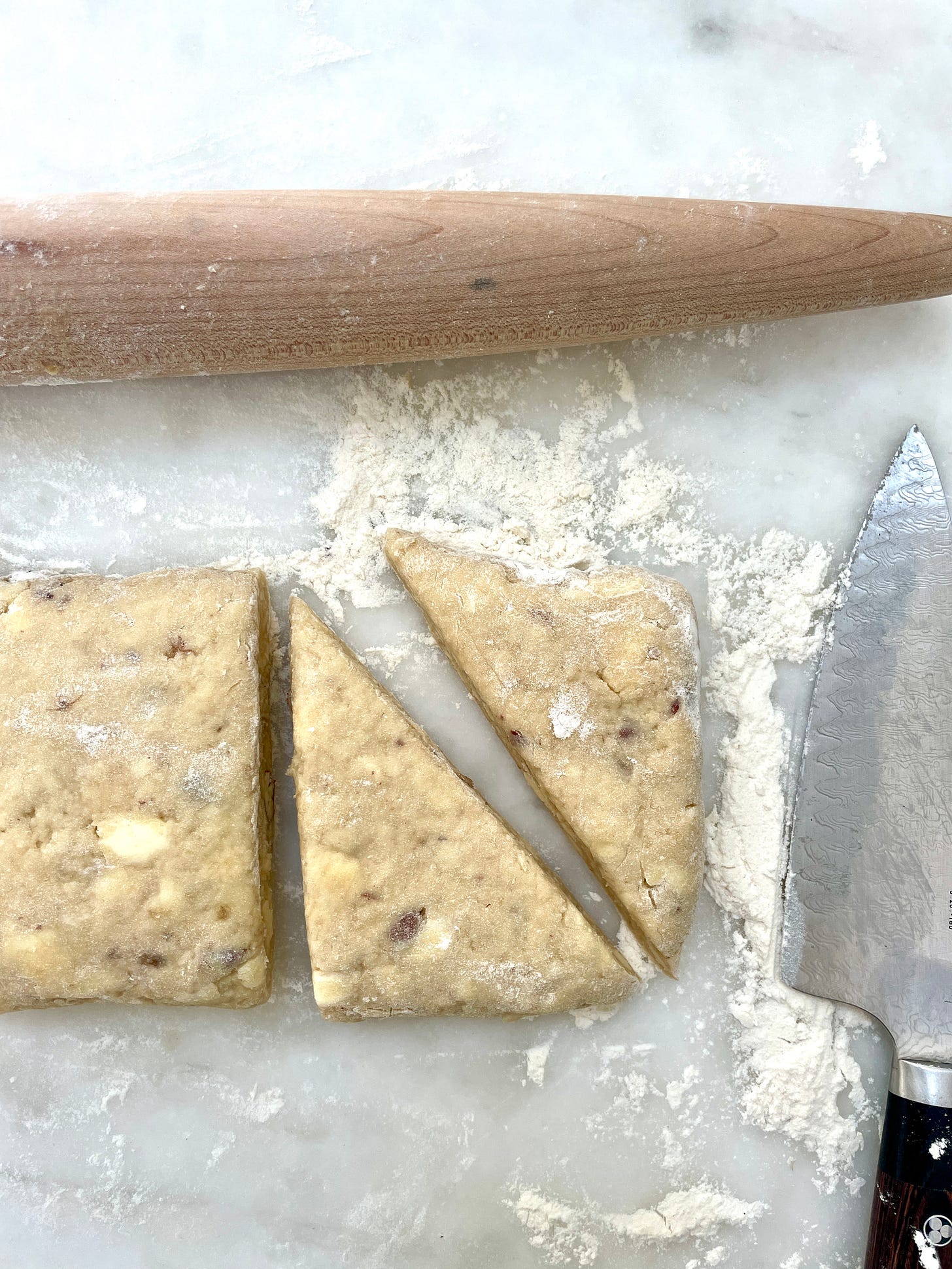
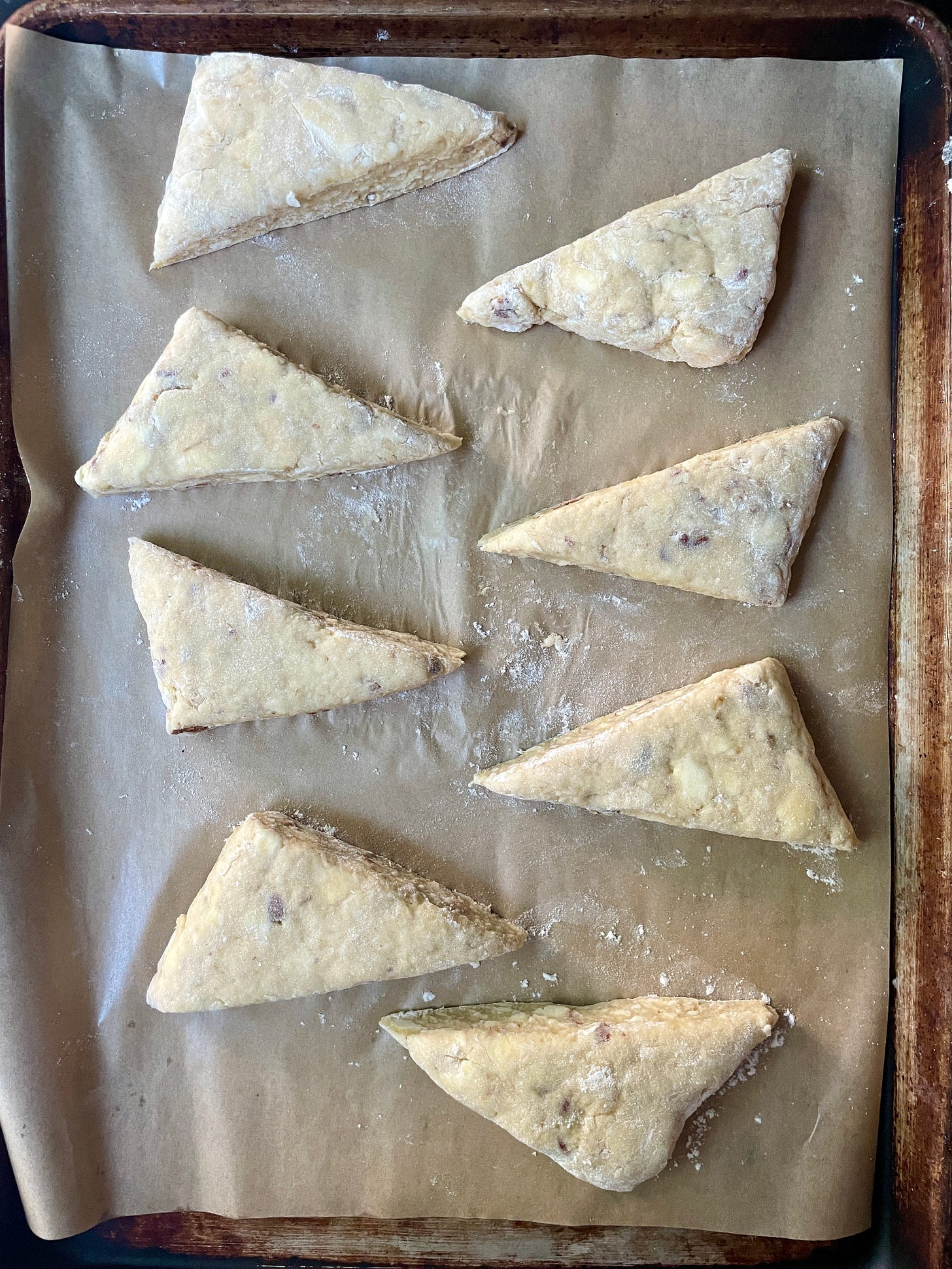
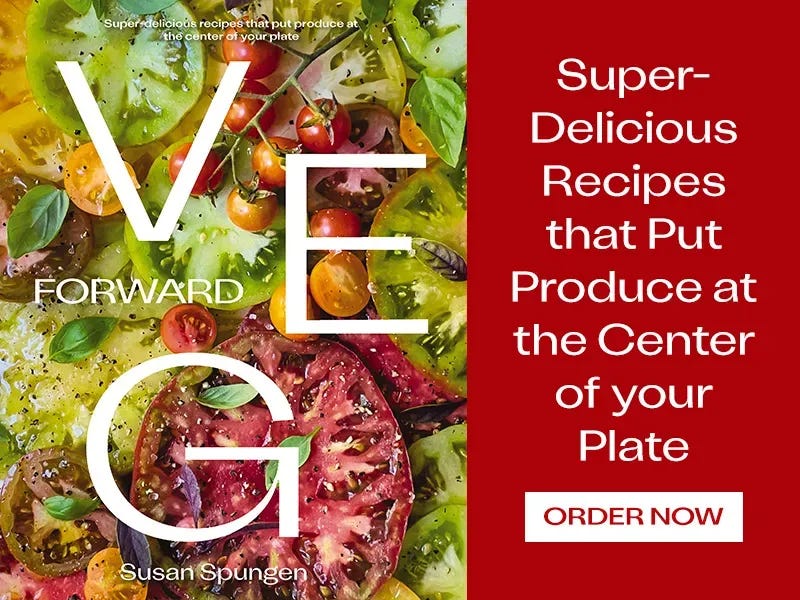
wow, susan, thank you for interviewing sarah and for the question about how to manage the sweets. her responses hit so close to home for me. the sugar. the shame. learning how to have a healthier relationship with food (no bad foods). all of it. i am a 68 year old lifelong baker who is caring for my 99 on sunday mum and i don't have any budget to buy sarah's book but would love to have it. thanks for the giveaway and for the recipe and for the interview.
Hi, Susan, this was a very interesting newsletter, with Sarah’s interview! Great questions! Pls do more of those! I would love the opportunity of trying her recipes and sharing them with my friends and neighbours!